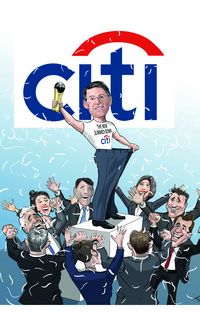Still standing
Equity capital markets activity slumped in every region during the IFR awards period – but the bankers at JP Morgan barely noticed. Despite headwinds throughout the year from various events, JP Morgan did not stumble and delivered for clients, making it IFR’s Equity House and Americas Equity House of the Year.
JP Morgan’s ECM franchise has rarely looked as robust as in 2016.
The bank enjoyed two years at the top of the ECM league tables in 2008 and 2009 when its financial strength was called upon worldwide to rebuild balance sheets – frequently those of its rivals.
JP Morgan had broken from the fringes of the top five before the financial crisis to become an established top three player but other US banks beat it to the top in subsequent years. But as the IFR awards period went on and banks were struggling to cope with the sharp drop in issuance, JP Morgan stood firm.
The bank did benefit from the kind of incoming calls that a US$2.5trn balance sheet generates – as it has every year since the crisis – so there were plenty of junior underwriting slots on rights issues, such as those for Saipem, Air Liquide and ArcelorMittal that each topped US$3bn.
Success was also built on often aggressive use of that balance sheet.
No deal demonstrated JP Morgan’s success in US ECM this year better than the US$2.2bn block trade in the shares of independent exploration and production company Anadarko Petroleum.
The September deal – the biggest E&P risk trade on record – netted the bank an estimated US$50m in underwriting fees, in an era in which block trades are better known for their poor economics. Moreover, the bank’s Wall Street rivals did not share a penny of the pay day.
It was the kind of outcome that showed not only why JP Morgan topped US equity underwriting league tables in 2016, but why it has been a Wall Street cornerstone for some 150 years.
Exploiting strength
The Anadarko block – to finance a US$2bn acquisition – required the bank to take on the overnight risk that oil prices might slump before it could sell the stock.
Thanks to that strong balance sheet, JP Morgan was able to underwrite the deal on its own without pre-sounding market demand to get comfortable with that level of risk (as other banks typically must). Pre-sounding raises the possibility of an expensive leak – something that Anadarko was able to avert by using only JP Morgan.
“If you are a large-cap company doing large-cap M&A, you want confidentially above all else,” said Jeff Zajkowski, JP Morgan’s co-head of ECM in the Americas.
The £3.3bn rights issue by Standard Chartered also stood out as new chief executive Bill Winters moved quickly to boost capital on the back of poor results. JP Morgan and Bank of America Merrill Lynch were able to underwrite the transaction without having to share the risk with others, making the process easier for StanChart.
The bank’s UK business is a massive factor in its steady performance – “the UK means JP Morgan starts the year fifteen-love up”, as one European rival put it – but the combination of so many corporate brokerage positions and the big balance sheet can leave the ECM team in some uncomfortable positions.
International rescue
Take the rescue rights issue by UK-listed platinum producer Lonmin. The £270m to be raised was substantially more than the South African miner’s market capitalisation so it was difficult to find truly attractive pricing. There was a high chance that JP Morgan would end up having to buy many of the shares alongside its joint underwriters and be nursing a big loss very quickly.
Nonetheless the bank backed the deal. The fundraising was undersubscribed but the banks managed to place most of the rump at a premium to market pricing – a remarkable outcome that showed many investors had been convinced the miner’s future was now secure. Those investors were right – and were sitting on an 88% profit in 60 days. The lessons learned in the distress of the crisis period are still benefiting clients of JP Morgan today.
The E&P sector was another area where the bank was close to clients and as a result dominated when issuance increased 40% throughout the year, with recapitalisations in the early part of the year followed by acquisitions when oil prices picked up.
“We just have a very good footprint in the E&P space and we have been there for clients as they have needed to recapitalise and as they have needed strategic advice,” Zajkowski said.
Top of the heap
JP Morgan ranked number one (up four places versus the prior year) in US IPOs with 10.3% market share and served as bookrunner on the most new issues (26) during the awards period. In a year when secondary offerings stole a bigger piece of the ECM pie, the firm held first place for all US common stock issuance with a 15% market share, up three percentage points, while six of the top 10 firms lost ground.
In the US, JP Morgan raised US$22.3bn in proceeds (from 143 issues – easily the most), a 9% fall over the previous year but a far milder drop than the industry’s 28.5% slump. The pattern was repeated in EMEA as the bank saw issuance volumes drop 2.4% to US$20.2bn but its main rivals had to cope with falls of 25%–55%. Remarkably, JP Morgan completed 103 deals while the next most active bank by deal number managed 73.
ECM issuance in Asia-Pacific may have only dropped 17.6% (to US$195bn) in the awards year to November 15, but Chinese banks savaged their international rivals. Goldman Sachs and UBS had vied for top spot in the region for years, but now rank sixth and fourth respectively, as four new entrants appear in the top 10.
For once, JP Morgan need not be ashamed of its Asian ECM business, which saw a drop from eighth to ninth.
League tables are not always the crucial criteria in IFR’s awards determinations, of course, but the bank’s ability to exploit its size and strength in markets where clients demanded more than ever is impossible to ignore.
New faces and structures
JP Morgan also secured top line slots on many of the biggest IPOs of the year, including as a sponsor of Postal Saving Bank of China’s US$7.6bn IPO. PSBC was the largest float of the year and JP Morgan featured on seven out of the top 10.
The weakness of the US new issue market was shown by the largest IPO on a US exchange – a dual-listing by Japan’s Line – ranking only 14th globally, with the largest IPO by a US company – MGM Growth Properties – one place behind. JP Morgan was on the top line of both deals.
JP Morgan also retained its top position in equity-linked issuance globally, though this was the one area where rivals increased issuance when JP Morgan did not.
A standout deal was the £2.88bn mandatory convertible bond from Vodafone, which smashed the record for the largest sterling issue ever in the asset class. It showed creativity, as the banks, with JP Morgan working alongside Morgan Stanley, used the equity-linked market to monetise US$5bn of loan notes.
Arguments have raged with rival bankers ever since the February deal as to whether it was a success or failure for the company as Vodafone received only low equity credit from S&P. Irrespective, it was a situation that did not naturally yield a convertible and yet was a neat way of injecting some life into the equity-linked market and handing investors desirable blue-chip exposure in size.
To see the digital version of this review, please click here.
To purchase printed copies or a PDF of this review, please email gloria.balbastro@tr.com
<object id="__symantecPKIClientMessenger" style="display: none;" data-install-updates-user-configuration="true" data-extension-version="0.4.0.129"></object>



